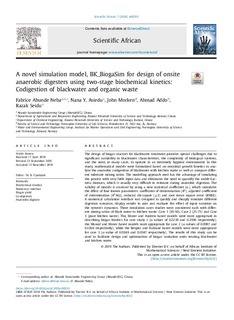| dc.contributor.author | Neba, Fabrice Abunde | |
| dc.contributor.author | Asiedu, Nana Yaw | |
| dc.contributor.author | Morken, John | |
| dc.contributor.author | Ahmad, Addo | |
| dc.contributor.author | Seidu, Razak | |
| dc.date.accessioned | 2020-02-06T08:08:23Z | |
| dc.date.available | 2020-02-06T08:08:23Z | |
| dc.date.created | 2019-11-26T15:51:42Z | |
| dc.date.issued | 2020 | |
| dc.identifier.citation | Scientific African. 2020, 7 . | nb_NO |
| dc.identifier.issn | 2468-2276 | |
| dc.identifier.uri | http://hdl.handle.net/11250/2639931 | |
| dc.description.abstract | The design of biogas reactors for blackwater treatment provides special challenges due to significant variability in blackwater characteristics, the complexity of biological systems, and the need, in many cases, to operate in an extremely hygienic environment. In this study, mathematical models were formulated based on microbial growth kinetics to analyze the anaerobic codigestion of blackwater with kitchen waste as well as compare different substrate mixing ratios. The modelling approach used has the advantage of simulating the process with very little input data and eliminates the need to quantify the viable bacteria biomass, which is usually very difficult to estimate during anaerobic digestion. The validity of models is assessed by using a new statistical coefficient (α), which cumulates the effect of four known parameters: coefficient of determination (R2), adjusted coefficient of determination (R2Adj), reduced chi-square (χ2) and root mean square error (RMSE). A numerical calculation interface was designed to quickly and cheaply simulate different digestion scenarios, display results to user and evaluate the effect of input variation on the system's dynamics. Three simulation cases studies were considered each with different mixing ratios of black water to kitchen waste: Case 1 (50:50), Case 2 (25:75) and Case 3 (pure kitchen waste). The, Moser and Andrew based models were most appropriate in describing biogas kinetics for case study 1 (α-values of 0.2238 and 0.2596 respectively), the Monod and Moser based models most appropriate for case 2 (α-values of 0.0987 and 0.1266 respectively), while the Bergter and Haldane based models were most appropriate for case 3 (α-value of 0.0348 and 0.0347 respectively). The results of this study can be used to facilitate design and optimization of biogas sanitation units treating blackwater and kitchen waste. | nb_NO |
| dc.language.iso | eng | nb_NO |
| dc.publisher | Elsevier | nb_NO |
| dc.rights | Navngivelse 4.0 Internasjonal | * |
| dc.rights.uri | http://creativecommons.org/licenses/by/4.0/deed.no | * |
| dc.title | A novel simulation model, BK_BiogaSim for design of onsite anaerobic digesters using two-stage biochemical kinetics: Codigestion of blackwater and organic waste | nb_NO |
| dc.type | Journal article | nb_NO |
| dc.type | Peer reviewed | nb_NO |
| dc.description.version | publishedVersion | nb_NO |
| dc.source.pagenumber | 18 | nb_NO |
| dc.source.volume | 7 | nb_NO |
| dc.source.journal | Scientific African | nb_NO |
| dc.identifier.doi | 10.1016/j.sciaf.2019.e00233 | |
| dc.identifier.cristin | 1752664 | |
| dc.description.localcode | © 2019 The Authors. Published by Elsevier B.V. on behalf of African Institute of Mathematical Sciences / Next Einstein Initiative. This isan open access article under the CC BY license. ( http://creativecommons.org/licenses/by/4.0/ ) | nb_NO |
| cristin.unitcode | 194,64,93,0 | |
| cristin.unitname | Institutt for havromsoperasjoner og byggteknikk | |
| cristin.ispublished | true | |
| cristin.fulltext | original | |
| cristin.qualitycode | 1 | |

